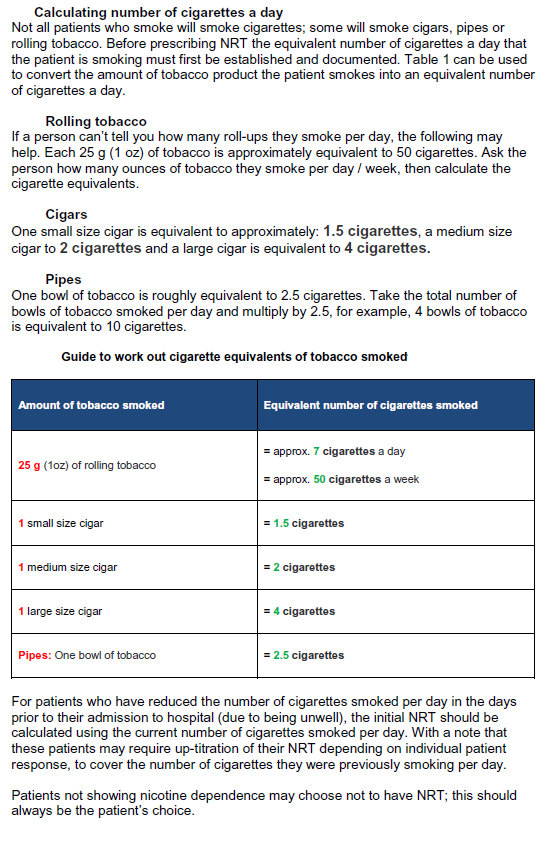Stopping smoking (evidence-based guidance)
There is evidence that helping smokers to stop smoking can be effective and highly cost-effective.
The essentials are:
- ASK about tobacco smoking at every opportunity
- ADVISE all smokers to stop smoking
- ASSIST all smokers to stop smoking
- ARRANGE follow up
There is evidence that even brief intervention (2-3 minutes) has a worthwhile effectiveness.
Useful features of intervention are to:
- set a date to stop completely
- review previous attempts to stop smoking - and what helped/hindered
- plan ahead - identify potential problems and strategies to cope
- plan how to handle alcohol-drinking situations
- try smoking cessation treatment e.g. nicotine replacement therapy, bupropion
Calculating the number of cigarettes a day (2):

All Wales Medicines Strategy Group. Initial Clinical Management of Adult Smokers in Secondary Care. June 2021.
NICE state (3):
Tell people who smoke that a range of interventions is available to help them stop smoking. Explain how to access them and refer people to stop-smoking support if appropriate
Ensure the following are accessible to adults who smoke:
- behavioural interventions:
- behavioural support (individual and group)
- very brief advice
- medicinally licensed products:
- cytisinicline
- nicotine replacement therapy (NRT) – short and long acting
- varenicline
- varenicline is recommended as an option in NICE technology appraisal guidance for people who smoke who have expressed a desire to quit smoking as part of a programme of behavioural support
- bupropion
- nicotine-containing e-cigarettes
- Allen Carr's Easyway in-person group seminar.
Consider NRT for young people aged 12 and over who are smoking and dependent on tobacco. If this is prescribed, offer it with behavioural support.
Do not offer cytisinicline, varenicline or bupropion to people under 18.
Do not offer cytisinicline to people aged 66 and over.
Offer behavioural support to people who smoke regardless of which option they choose to help them stop smoking, unless they have chosen the Allen Carr Easyway in-person group seminar. Explain how to access this support.
Discuss with people which options to use to stop smoking, taking into account:
- their preferences, health and social circumstances
- any medicines they are taking
- any contraindications and the potential for adverse effects
- their previous experience of stop-smoking aids.
Also see the advice in the recommendations on medicinally licensed products, and the recommendations on nicotine-containing e-cigarettes.
Advise people (as appropriate for their age) that the following options, when combined with behavioural support, are more likely to result in them successfully stopping smoking:
- cytisinicline
- a combination of short-acting and long-acting NRT
- varenicline
- nicotine-containing e-cigarettes
Advise people (as appropriate for their age) that the options that are less likely to result in them successfully stopping smoking, when combined with behavioural support, are:
- bupropion
- short-acting NRT used without long-acting NRT
- long-acting NRT used without short-acting NRT
For adults, prescribe or provide bupropion, cytisinicline, NRT or varenicline before they stop smoking, and for:
- bupropion, agree a quit date set within the first 2 weeks of treatment and reassess the person shortly before the prescription ends
- cytisinicline, agree a quit date set within the first 5 days of treatment and reassess the person shortly before the prescription ends
- NRT, agree a quit date and ensure the person has NRT ready to start the day before the quit date
- varenicline, agree a quit date and start the treatment 1 to 2 weeks before this date; reassess the person shortly before the prescription ends
Study evidence shows that among men and women from diverse racial and ethnic groups, quitting smoking was associated with large reductions in the excess mortality associated with continued smoking (4)
- all-cause mortality rate ratio (RR) for current vs never smoking was 2.80 overall
- when comparing those who quit smoking before age 45 years with never-smokers, all-cause mortality RRs were 1.15
A systematic review stated that (5):
- most effective interventions were nicotine e-cigarettes, varenicline and cytisine
- found high-certainty evidence that when compared to control, nicotine e-cigarettes, varenicline and cytisine might lead to an additional eight (95% CrI 4-13), eight (6-10) and seven (4-12) additional quitters per 100, respectively
Reference:
- British Heart Foundation, Factfile 6/99.
- All Wales Medicines Strategy Group. Initial Clinical Management of Adult Smokers in Secondary Care. June 2021.
- NICE (February 2025). Tobacco: preventing uptake, promoting quitting and treating dependence
- Thomson B, Emberson J, Lacey B, et al. Association Between Smoking, Smoking Cessation, and Mortality by Race, Ethnicity, and Sex Among US Adults. JAMA Netw Open. 2022;5(10):e2231480. doi:10.1001/jamanetworkopen.2022.31480
- Lindson N et al. Pharmacological and electronic cigarette interventions for smoking cessation in adults: component network meta-analyses. Cochrane Database of Systematic Reviews 2023, Issue 9. Art. No.: CD015226. DOI: 10.1002/14651858.CD015226.pub2. Accessed 16 September 2023.
Related pages
- Efficacy
- Smoking
- Nicotine replacement therapy
- Bupropion
- Smoking and ischaemic heart disease
- Bupropion and weight gain
- NICE guidance - use of nicotine replacement therapy (NRT), cytisinicline, varenicline and bupropion for smoking cessation
- Varenicline
- Rimonabant
- Carbon monoxide monitoring in smoking cessation
- NICE guidance - smoking cessation in pregnancy
- Smoking (cigarette smoking equivalences to cigar smoking and roll-ups)
- Stopping smoking and weight gain
- Smoking cessation and reduction in risk of head and neck cancers
- Cytisinicline for vaping cessation
Create an account to add page annotations
Annotations allow you to add information to this page that would be handy to have on hand during a consultation. E.g. a website or number. This information will always show when you visit this page.